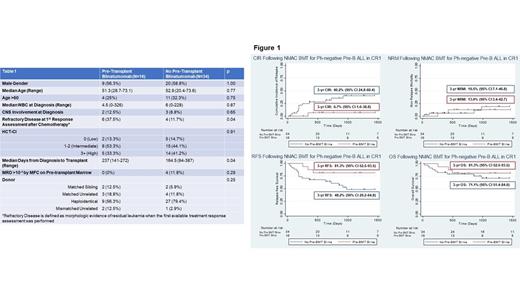Abstract
Background: The benefit of allogeneic blood or marrow transplantation (alloBMT) following myeloablative conditioning (MAC) in first complete remission (CR1) compared to chemotherapy has been demonstrated in a randomized trial for adults with acute lymphoblastic leukemia (ALL). Persistence of measurable residual disease (MRD) prior to alloBMT confers an increased risk of relapse. Blinatumomab eradicates persistent or recurrent MRD at levels ≥10 -3 in 78% of B ALL. However, post-hoc analyses of patients who have undergone alloBMT following blinatumomab for MRD demonstrate non-relapse mortality (NRM) of 36.5%. NRM following nonmyeloablative (NMAC) alloBMT with high-dose post-transplantation cyclophosphamide (PTCy) is just 11%. Given broadly similar outcomes between HLA-matched MAC alloBMT and HLA-haploidentical NMAC alloBMT following PTCy, we have shifted to using exclusively NMAC alloBMT with PTCy and sought to explore outcomes depending on receipt of pre-transplant blinatumomab.
Methods: The bone marrow transplant database at Johns Hopkins was queried for adult patients with Ph-negative B-ALL who received NMAC alloBMT in CR1 using PTCy between January 2008 and July 2020. Characteristics of patients were summarized and compared using the student's T test for continuous variables and Fisher's exact test for categorical variables. Estimators of OS and RFS were reported using the Kaplan-Meier method. Differences in time-to-event outcomes were estimated using Cox proportional hazards model for OS and RFS, and Fine and Gray's model for cumulative incidence of relapse (CIR)/NRM considering competing events.
Results: Among the 50 identified patients undergoing 1 st transplant in CR1 with NMAC, all received conditioning with fludarabine and cyclophosphamide followed by total body irradiation (TBI). In addition to PTCy, all patients received mycophenolate mofetil and either tacrolimus or sirolimus as GVHD prophylaxis. Sixteen patients (32%) received blinatumomab in CR1 or achieved CR1 following blinatumomab and proceeded to transplant without intervening therapy, while 34 patients (68%) did not. At the time of treatment with blinatumomab; 3 patients had >5% blasts after chemotherapy, 8 had persistent or recurrent MRD >10 -4 after chemotherapy, and 5 had no evidence of MRD at a sensitivity of 10 -4. Among the 5 MRD- patients treated with blinatumomab; 1 had been refractory to their first course of chemotherapy (67% blasts), 3 had MRD >10 -4 at the first MRD response assessment following chemotherapy, and 1 had CNS involvement at diagnosis. The demographics of these two groups are presented in Table 1 and separated by pre-transplant blinatumomab status. The groups were well balanced in terms of gender, age, WBC at diagnosis, CNS involvement at diagnosis, and donor type. Patients who received blinatumomab were more likely to have been refractory to their initial course of chemotherapy and were transplanted later after their initial diagnosis than those who did not. All patients who received blinatumomab were MRD-negative at a sensitivity of 10 -4 prior to their transplant, while 11.8% of patients who did not receive blinatumomab were MRD-positive.
Relapse-free and overall survival, cumulative incidence of relapse, and non-relapse mortality by receipt of blinatumomab prior to transplant are shown in Figure 1. Non-relapse mortality was not increased among patients who received pre-transplant blinatumomab (HR=1.06, p=0.94). The causes of non-relapse mortality included GVHD (1) and secondary malignancy (1) in patients who received blinatumomab; and infection (1), bleeding (1), secondary malignancy (1), and other (1) in patients who did not receive blinatumomab. Receipt of pre-transplant blinatumomab was associated with a decreased cumulative incidence of relapse (HR=0.15, p=0.07) and improved relapse-free survival (HR=0.32, p=0.07). Overall survival (HR=0.63, p=0.5) between the two groups was similar, likely reflecting the efficacy of salvage therapies such as CD19 CAR T cells; blinatumomab; and inotuzumab in the relapsed, post-transplant population.
Conclusions: Treatment with blinatumomab prior to NMAC alloBMT with PTCy in CR1 for Ph-negative B ALL did not increase NRM and produced a 3-year RFS of 81%. The low CIR and NRM of NMAC alloBMT in an MRD-negative CR1 following blinatumomab suggest it could be a viable alternative to MAC.
Webster: AmGen: Consultancy; Pfizer: Consultancy. DeZern: Takeda: Consultancy, Membership on an entity's Board of Directors or advisory committees; Taiho: Consultancy, Membership on an entity's Board of Directors or advisory committees; Novartis: Consultancy, Membership on an entity's Board of Directors or advisory committees; Bristol-Myers Squibb: Consultancy, Membership on an entity's Board of Directors or advisory committees. Levis: Takeda: Honoraria; BMS: Consultancy, Honoraria, Membership on an entity's Board of Directors or advisory committees; Pfizer: Consultancy, Honoraria; Jazz: Consultancy, Honoraria; Astellas and FujiFilm: Research Funding; Amgen, Astellas Pharma, Daiichi-Sankyo, FujiFilm, and Menarini: Honoraria; AbbVie: Consultancy, Honoraria, Membership on an entity's Board of Directors or advisory committees. Ghiaur: Syros Pharmaceuticals: Consultancy; Menarini Richerche: Research Funding. Hourigan: Sellas: Research Funding. Jain: Syneos Health: Research Funding; CTI Biopharma: Research Funding; CareDx: Other: for advisory board participation; Bristol Myers Squibb: Other: for advisory board participation; Targeted Healthcare Communications: Consultancy. Ali: Janssen: Consultancy; BMS: Consultancy; Oncopeptides: Consultancy; Sanofi: Consultancy; Amgen: Consultancy; Aduro: Consultancy; Poseida: Research Funding; Aduro: Research Funding; BMS: Research Funding.


This feature is available to Subscribers Only
Sign In or Create an Account Close Modal